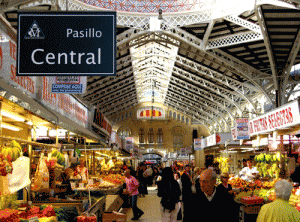The city of València (in castellano, Valencia) overlooks the Mediterranean Sea and is one of Spain's most important and populous cities, being the third largest city in the Iberian Peninsula after Barcelona and Madrid. The city's name was given by the Romans who named the territory ‘Valentia Edetanorum’ (second century BC.)
City Districts (Distritos)
The city of Valencia is divided into 19 districts (see map), which are in turn subdivided into Barrios and Pedanías (neighbourhoods). These neighbourhoods are grouped into seven decentralized management bodies (municipal district councils); these being Ciutat Vella, Russafa, Abastos, Patraix, Trànsits, Exposició and Marítim.
Some of the neighborhoods and districts were independent municipalities which joined the city in the second half of the nineteenth century.
| District |
Barrios & Pedanías |
| Algirós |
L'Illa Perduda, Ciutat Jardí, L'Amistat, La Bega Baixa y La Carrasca |
| Benicalap |
Benicalap y Ciutat Fallera |
| Benimaclet |
Benimaclet y Camí de Vera |
| Camins al Grau |
Ayora, Albors, La Creu del Grau, Camí Fondo y Penya-Roja |
| Campanar |
Campanar, Les Tendetes, El Calvari y Sant Pau |
| Ciutat Vella |
La Seu, La Xerea, El Carme, El Pilar, El Mercat y Sant Francesc |
| L'Eixample |
Ruzafa, El Pla del Remei y Gran Vía |
| Extramurs |
El Botànic, La Roqueta, La Petxina y Arrancapins |
| Jesús |
La Raiosa, L'Hort de Senabre, La Creu Coberta, San Marcelino y Camí Real |
| L'Olivereta |
Nou Moles, Soternes, Tres Forques, La Fuensanta y La Llum |
| Patraix |
Patraix, Sant Isidre, Vara de Quart, Safranar y Favara |
| El Pla de Real |
Exposició, Mestalla, Jaume Roig y Ciutat Universitària |
| Poblats Marítims |
El Grao, Cabañal-Cañamelar, Malvarrosa, Beteró y Nazaret |
| Poblats del Nord |
Benifaraig, Pueblo Nuevo, Carpesa, Casas de Barcena, Mahuella, Masarrochos y Borbotó |
| Poblats del Oest |
Benimámet y Beniferri |
| Poblats del Sud |
Horno de Alcedo, Castellar-Oliveral, Pinedo, El Saler, El Palmar, El Perellonet, La Torre y Faitanar |
| Quatre Carreres |
Monteolivete, En Corts, Malilla, Fuente de San Luis, Na Rovella, La Punta y Ciudad de las Artes y las Ciencias |
| Rascanya |
Els Orriols, Torrefiel y Sant Llorenç |
| La Saidia |
Marxalenes, Morvedre, Trinitat, Tormos y Sant Antoni |
The City of Arts and Sciences is a unique complex devoted to scientific and cultural dissemination which is made up of five main elements: L'Hemisfèric (IMAX cinema and digital projections), El Umbracle (a landscaped vantage point and car park); El Museo de las Ciencias Príncipe Felipe (an innovative centre of interactive science); L'Oceanogràfic (the largest aquarium in Europe with over 500 marine species); the Palau de les Arts Reina Sofia (the Valencia Opera House); and L'Ágora gives the complex a multifunctional space.
Valencia is known all over the world for the Fallas which have their origin in a ritual celebrating the arrival of Spring, this was later adopteded by the church into a commemoration of the day of San Jose. The city's inhabitants threw their old furniture and rubbish into the street and then burnt it as a symbol of purification, showing that Winter had passed and Spring had arrived. Over time, they also began to burn satirical figures representing those in the city they most detested.
Nightclubs and Bars
 A number of bars and clubs can be found around the city centre in easy walking distance. Valencia is a city that never sleeps and all week long there is always something "on the go" (although the larger clubs mainly open towards the end of the week with Friday and Saturday being the busiest nights).
A number of bars and clubs can be found around the city centre in easy walking distance. Valencia is a city that never sleeps and all week long there is always something "on the go" (although the larger clubs mainly open towards the end of the week with Friday and Saturday being the busiest nights).
There are a number of free publications to look out for:
- “Cool Carmen “ - a well-designed and handy map of El Carmen (in English). Giving locations and descriptions of the best shops, bars and restaurants, it's available free in shops and bars all over El Carmen.
- “24/7 Valencia “ - another English Magazine - and also "A Little Beat" and "Mondo Sonoro", these are all good free guides to what’s happening on the local dance and music scene.
Shopping
 Valencia is Spains third largest city and so it comes as no surprise that the shopping possibilities are endless. From open air flea markets, craft shops and shopping malls to the latest in designer fashions - Valencia has it all.
Valencia is Spains third largest city and so it comes as no surprise that the shopping possibilities are endless. From open air flea markets, craft shops and shopping malls to the latest in designer fashions - Valencia has it all.
The region produces Lladró porcelain, Manises stoneware, and glassware. Local craftspeople take pride in their azulejos -- brightly coloured ceramic tiles, first developed during the Muslim occupation. All kinds of ceramics are produced and other artisan products include lace, basket work,silk goods and hand crafted fans.
Calle Colon and the surrounding district is the area for the fashion conscious; Calle Jorge Juan for shoes, hand bags and accessories; Calle Poeta Querol for mens fashion, while La Plaza del Ayuntamiento has quality boutiques for men and women.
The Central Market - the largest covered market in Spain - with its numerous delicatessens is the ideal place to stock up on hams, chorizos, cheeses, fish and fresh produce.


 A number of bars and clubs can be found around the city centre in easy walking distance. Valencia is a city that never sleeps and all week long there is always something "on the go" (although the larger clubs mainly open towards the end of the week with Friday and Saturday being the busiest nights).
A number of bars and clubs can be found around the city centre in easy walking distance. Valencia is a city that never sleeps and all week long there is always something "on the go" (although the larger clubs mainly open towards the end of the week with Friday and Saturday being the busiest nights). Valencia is Spains third largest city and so it comes as no surprise that the shopping possibilities are endless. From open air flea markets, craft shops and shopping malls to the latest in designer fashions - Valencia has it all.
Valencia is Spains third largest city and so it comes as no surprise that the shopping possibilities are endless. From open air flea markets, craft shops and shopping malls to the latest in designer fashions - Valencia has it all.